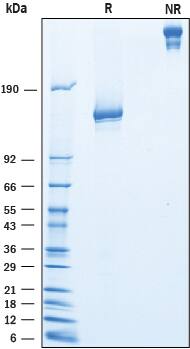Recombinant Mouse IGSF2/CD101 Fc Chimera Protein, CF
R&D Systems, part of Bio-Techne | Catalog # 3368-CD

Key Product Details
Source
NS0
Accession #
Structure / Form
Disulfide-linked homodimer
Conjugate
Unconjugated
Applications
Bioactivity
Product Specifications
Source
Mouse myeloma cell line, NS0-derived mouse IGSF2/CD101 protein
| Mouse CD101 (Gln21-Phe974) Accession # A8E0Y8 |
IEGRMDP | Mouse IgG2a (Glu98-Lys330) |
| N-terminus | C-terminus |
Purity
>95%, by SDS-PAGE visualized with Silver Staining and quantitative densitometry by Coomassie® Blue Staining.
Endotoxin Level
<0.10 EU per 1 μg of the protein by the LAL method.
N-terminal Sequence Analysis
No results obtained. Gln21 inferred from enzymatic pyroglutamate treatment revealing Arg22.
Predicted Molecular Mass
133 kDa
SDS-PAGE
121-150 kDa, reducing conditions
Activity
Measured by its ability to inhibit anti-CD3-induced proliferation of stimulated human T cells.
The ED50 for this effect is 1.4-8.4 μg/mL.
The ED50 for this effect is 1.4-8.4 μg/mL.
Scientific Data Images for Recombinant Mouse IGSF2/CD101 Fc Chimera Protein, CF
Recombinant Mouse IGSF2/CD101 Fc Chimera Protein Bioactivity
Recombinant Mouse IGSF2/CD101 Fc Chimera (Catalog # 3368-CD) inhibits anti-CD3 antibody induced human T cell proliferation. The ED50 for this effect is 1.4-8.4 μg/mL.Recombinant Mouse IGSF2/CD101 Fc Chimera Protein SDS-PAGE
2 μg/lane of Recombinant Mouse IGSF2/CD101 was resolved with SDS-PAGE under reducing (R) and non-reducing (NR) conditions and visualized by Coomassie® Blue staining, showing bands at 121-150 kDa and 240-280 kDa, respectively.Formulation, Preparation and Storage
3368-CD
| Formulation | Lyophilized from a 0.2 μm filtered solution in PBS. |
| Reconstitution | Reconstitute at 400 μg/mL in PBS. |
| Shipping | The product is shipped with polar packs. Upon receipt, store it immediately at the temperature recommended below. |
| Stability & Storage | Use a manual defrost freezer and avoid repeated freeze-thaw cycles.
|
Background: IGSF2/CD101
References
- Stipp, C. et al. (2001) J. Biol. Chem. 276:40545.
- Bouloc, A. et al. (2000) Eur. J. Immunol. 30:3132.
- Rivas, A. et al. (1995) J. Immunol. 154:4423.
- Ruegg, C. et al. (1995) J. Immunol. 154:4434-CD.
- Fernandez, I. et al. (2007) J. Immunol. 179:2808.
- Hua, J. et al. (2015) J. Immunol. 195:3642.
- Soares, L. et al. (1998) J. Immunol. 161:209.
- Brimnes, J. et al. (2005) J. Immunol. 174:5814.
- Kumar, B. et al. (2017) Cell Rep. 20:2921.
- Rainbow, D. et al. (2011) J Immunol. 187:325.
- Okuno, M. et al. (2017) J Diabetes Investig. 8:286.
- Meyer, N. et al. (2005) J. Invest. Dermatol. 124:668.
- Schey, R. et al. (2016) Mucosal Immunol. 9:1205.
- Mackelprang, R. et al. (2017) PLoS Pathog. 13:e1006703.
Long Name
Immunoglobulin Superfamily, Member 2
Alternate Names
CD101, Leukocyte Surface Protein, V7
Gene Symbol
CD101
UniProt
Additional IGSF2/CD101 Products
Product Documents for Recombinant Mouse IGSF2/CD101 Fc Chimera Protein, CF
Product Specific Notices for Recombinant Mouse IGSF2/CD101 Fc Chimera Protein, CF
For research use only
